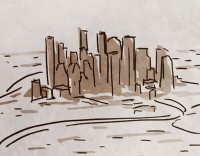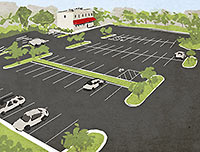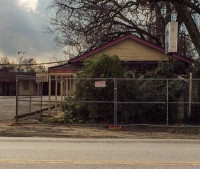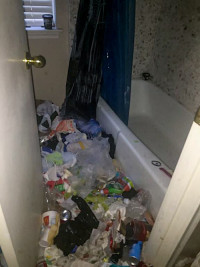U.S. GOVERNMENT WILL TRY TO TRACK ANONYMOUS CASH REAL ESTATE BUYERS Meanwhile, in Manhattan and Miami: The U.S. Treasury Department announced an upcoming trial run for keeping tabs on the identities of “luxury real estate” buyers in 2 high-volume markets, citing concerns that cash purchases by anonymous shell corporations are being used to safeguard ill-gotten assets. From March through August, title insurance companies in Manhattan will be required to identify and report the buyers of any property priced above $3 million; in Miami-Dade County, the threshold will be $1 million. The Department says that permanent nationwide reporting requirements could be developed if many sales involving suspicious money are uncovered during the trial period. [New York Times]
Quicklink
COMMENT OF THE DAY: KICK BACK, RELAX, AND ENJOY THE BUST  “Downturn or not, Houston was so lacking in new development, ALL of what is getting built needed to be built . . . we were sooooooo far behind. The building boom allowed Houston to catch up to where it should have been — so these other delays/cancels are good for now. The pent-up demand will fill up what’s already in the works, and the delays/cancels can get after it at another time. What Houston has developed in the last several years has transformed the city, for the better. During the slowdown, we can catch our breathe and savor/enjoy the successes of the recent boom, and regroup and prepare for the next great haul.” [TXT, commenting on The University of Texas ‘Invasion’; Houston’s Hottest Neighborhoods] Illustration: Lulu
“Downturn or not, Houston was so lacking in new development, ALL of what is getting built needed to be built . . . we were sooooooo far behind. The building boom allowed Houston to catch up to where it should have been — so these other delays/cancels are good for now. The pent-up demand will fill up what’s already in the works, and the delays/cancels can get after it at another time. What Houston has developed in the last several years has transformed the city, for the better. During the slowdown, we can catch our breathe and savor/enjoy the successes of the recent boom, and regroup and prepare for the next great haul.” [TXT, commenting on The University of Texas ‘Invasion’; Houston’s Hottest Neighborhoods] Illustration: Lulu
A GLIMPSE OF THE HIDDEN PECAN AT 509 LOUISIANA ST., NOW THAT THE BUILDING IS OUT OF THE WAY  While much of the 1906 structure that formerly stood at 509 Louisiana St. was still on site as of early afternoon yesterday, the pieces had mostly been rearranged. A couple of excavators can be seen picking them over in this shot sent in by a reader. The once-secret pecan tree is also hanging out in the open as it waits for the axe — look for the branches peeking out around the corner of the Calpine Center parking garage entrance, on the left edge of the shot. [Previously on Swamplot] Photo: Jack Miller via Swamplot inbox
While much of the 1906 structure that formerly stood at 509 Louisiana St. was still on site as of early afternoon yesterday, the pieces had mostly been rearranged. A couple of excavators can be seen picking them over in this shot sent in by a reader. The once-secret pecan tree is also hanging out in the open as it waits for the axe — look for the branches peeking out around the corner of the Calpine Center parking garage entrance, on the left edge of the shot. [Previously on Swamplot] Photo: Jack Miller via Swamplot inbox
COMMENT OF THE DAY: HOW NATURAL SELECTION ELIMINATES HOUSTON PEDESTRIANS  “Biology has words to describe the relationship between parking and driving. ‘Arms race’ and ‘co-evolution’ fit pretty well. If you find a creature that has evolved to devote a lot of its energy to producing toxins, you’ll find some other creature that has evolved to survive those toxins — the two are in an arms race with each other, and have co-evolved these capabilities. One becomes a little more toxic, the other becomes a little more immune to that toxin. Other organisms can’t invade that relationship because they aren’t toxic enough or immune enough. From this perspective, large parking lots and heavy reliance on cars can be seen as Houston’s defense mechanism. Houston is immune to walkability because driving and parking have co-evolved to such extremes here. There’s no stable strategy to provide a path from where we are to where the new urbanists want to be.” [Memebag, commenting on Houston’s Pothole Progress; Reagan HS Name Staying for Now] Illustration: Lulu
“Biology has words to describe the relationship between parking and driving. ‘Arms race’ and ‘co-evolution’ fit pretty well. If you find a creature that has evolved to devote a lot of its energy to producing toxins, you’ll find some other creature that has evolved to survive those toxins — the two are in an arms race with each other, and have co-evolved these capabilities. One becomes a little more toxic, the other becomes a little more immune to that toxin. Other organisms can’t invade that relationship because they aren’t toxic enough or immune enough. From this perspective, large parking lots and heavy reliance on cars can be seen as Houston’s defense mechanism. Houston is immune to walkability because driving and parking have co-evolved to such extremes here. There’s no stable strategy to provide a path from where we are to where the new urbanists want to be.” [Memebag, commenting on Houston’s Pothole Progress; Reagan HS Name Staying for Now] Illustration: Lulu
SWEEPING UP THE CRUMBS AT THE FORMER HOME OF MIYAKO, RED ONION, AND MADRAS PAVILION  A reader surveys the scant leftovers of the once-restaurant-filled office park at Kirby at Norfolk this morning. The knock-’em-down phase of the demolition of Corporate Plaza II and III, which began in mid-December, appears to have wrapped up and transitioned into the haul-’em-away. The complex’s still-standing parking garage, pictured on the right, was issued its demo permit on Friday. The last structure of the office park trio, the Corporate Plaza I midrise (hiding unsuccessfully behind the garage), has recently acquired a sash of debris netting around the middle; Nancy Sarnoff reports that Corporate Plaza I will be demolished as well. The complex should be fully done in by the end of April. [Chron.com, previously on Swamplot] Photo of 3910 and 3930 Kirby Dr.: Swamplot inbox
A reader surveys the scant leftovers of the once-restaurant-filled office park at Kirby at Norfolk this morning. The knock-’em-down phase of the demolition of Corporate Plaza II and III, which began in mid-December, appears to have wrapped up and transitioned into the haul-’em-away. The complex’s still-standing parking garage, pictured on the right, was issued its demo permit on Friday. The last structure of the office park trio, the Corporate Plaza I midrise (hiding unsuccessfully behind the garage), has recently acquired a sash of debris netting around the middle; Nancy Sarnoff reports that Corporate Plaza I will be demolished as well. The complex should be fully done in by the end of April. [Chron.com, previously on Swamplot] Photo of 3910 and 3930 Kirby Dr.: Swamplot inbox
RUNNER-UP COMMENT OF THE DAY: READY FOR ICING OUTSIDE THE INNER LOOP  ” . . . I think the real opportunity to expand affordable housing is in Houston’s ‘donut of despair’. The area between 610 and the Beltway (except around the Spring Branch area) is full of acres and acres of empty land. With a huge push from the City, these areas could be redeveloped into truly affordable neighborhoods with homes in the $150-250k range.” [Old School, commenting on Houston Home Sales Continue To Tumble; One More Link in the Grand Parkway] Illustration: Lulu
” . . . I think the real opportunity to expand affordable housing is in Houston’s ‘donut of despair’. The area between 610 and the Beltway (except around the Spring Branch area) is full of acres and acres of empty land. With a huge push from the City, these areas could be redeveloped into truly affordable neighborhoods with homes in the $150-250k range.” [Old School, commenting on Houston Home Sales Continue To Tumble; One More Link in the Grand Parkway] Illustration: Lulu
H-E-B EXPLORING TINY STORES AS WALMART THROWS IN THE TOWEL Meanwhile, in San Antonio: As big-box giant Walmart nixes all of its Express mini-stores amid a larger batch of closures, H-E-B is making way for a full-service convenience store with an attached Wendy’s near the northwest corner of Loop 1604. H-E-B officials have been slow to confirm details of the new store, which is reportedly on the order of 7,500 sq. ft. and estimated to cost roughly $2.7 million. The Texas grocery chain frequently operates a small kiosk at its gas-proffering full-sized store locations, but only a handful of the full-service convenience stores currently exist; the one in Lytle, TX, contains a Whataburger. [Virtual Builders Exchange, via PaperCity]
COMMENT OF THE DAY: AN INSIDE-THE-LOOP STATUS REPORT  “I am a real estate agent in the Heights-Montrose area. While sales are down a bit in volume, prices are still slowly rising. Correct: 2014 was a banner year, the likes of which may not be seen again for another few years. We are seeing price reductions on listings that were speculating the continuation of the rapid price increases — however, when the prices are brought down, they still sell. Here inside the Loop, we are quite busy, and the good stuff under 500k is moving nicely.” [Freddie, commenting on Houston Home Sales Continue To Tumble; One More Link in the Grand Parkway] Illustration: Lulu
“I am a real estate agent in the Heights-Montrose area. While sales are down a bit in volume, prices are still slowly rising. Correct: 2014 was a banner year, the likes of which may not be seen again for another few years. We are seeing price reductions on listings that were speculating the continuation of the rapid price increases — however, when the prices are brought down, they still sell. Here inside the Loop, we are quite busy, and the good stuff under 500k is moving nicely.” [Freddie, commenting on Houston Home Sales Continue To Tumble; One More Link in the Grand Parkway] Illustration: Lulu
COMMENT OF THE DAY: ARCHIVING HOUSTON’S PAST FOR FUTURE AFFECTATION  “I am going to put together a coffee table book called ‘When Houston Sucked’ that will document Houston’s former lack of glory. There will be photos of a half-empty Town and Country Mall . . . a picture of the 10k running route map in the old downtown YMCA that warned women not to run on the bayou trail under Memorial Drive at night . . . a map showing the work of serial killers and arsonists in the Heights . . . and lots of pictures of strip malls and garden-style apartment complexes. All the yuppies, hipsters, and millenials need to understand that Houston used to really suck, so they can feel guilty about the ugliness we lose every day . . .” [Old School, commenting on Paradise Lost on Hempstead Rd.]
“I am going to put together a coffee table book called ‘When Houston Sucked’ that will document Houston’s former lack of glory. There will be photos of a half-empty Town and Country Mall . . . a picture of the 10k running route map in the old downtown YMCA that warned women not to run on the bayou trail under Memorial Drive at night . . . a map showing the work of serial killers and arsonists in the Heights . . . and lots of pictures of strip malls and garden-style apartment complexes. All the yuppies, hipsters, and millenials need to understand that Houston used to really suck, so they can feel guilty about the ugliness we lose every day . . .” [Old School, commenting on Paradise Lost on Hempstead Rd.]
AND NOW, WATCH THE RED LINE RUSH FROM BELL ST. TO BURNETT STATION AND BACK IN 49 SECONDS Take a break from the Downtown bustle, even if its just for a couple of seconds — frequent Swamplot photo contributor Jackson Myers captured this sped-up video of a light-rail ride from Bell St. up to Burnett Station, and even manages to hop in the conductor’s compartment for the return trip. Video: Jackson Myers via Swamplot inbox
MOVING FORWARD WITHOUT TENANTS ON 1.5 MILLION SQ.FT. OF WAREHOUSE SPACE IN BAYTOWN  “It’s all about rail,” Robert Clay tells Cara Smith of the HBJ — despite having no tenants lined up, Clay Development plans to begin construction this month on the first of 3 500,000-plus-change-sq.ft. railcar-friendly warehouses on Borusan Rd., southwest of the Grand Pkwy.’s Cedar Bayou crossing. Clay purchased the 80-acre section of Baytown’s Cedar Crossing Industrial Park (the Gulf Coast’s largest industrial park, at 3/4ths the size of Manhattan) at the end of December. Clay’s economic predictions are “more optimistic for 2016” than they were for last year —Â Low natural gas prices have fueled a $35-billion plastics and petrochemical boom along the Gulf Coast, and storage demand could increase thanks to the expansion of the Panama Canal. The building could be finished by August. [HBJ, Houston Chronicle] Map of proposed distribution facility location: Clay Development
“It’s all about rail,” Robert Clay tells Cara Smith of the HBJ — despite having no tenants lined up, Clay Development plans to begin construction this month on the first of 3 500,000-plus-change-sq.ft. railcar-friendly warehouses on Borusan Rd., southwest of the Grand Pkwy.’s Cedar Bayou crossing. Clay purchased the 80-acre section of Baytown’s Cedar Crossing Industrial Park (the Gulf Coast’s largest industrial park, at 3/4ths the size of Manhattan) at the end of December. Clay’s economic predictions are “more optimistic for 2016” than they were for last year —Â Low natural gas prices have fueled a $35-billion plastics and petrochemical boom along the Gulf Coast, and storage demand could increase thanks to the expansion of the Panama Canal. The building could be finished by August. [HBJ, Houston Chronicle] Map of proposed distribution facility location: Clay Development
ST. PAUL SUBURB REFUSES BUS CONNECTIVITY IN ORDER TO STAY “PRETTY RURAL-LOOKING” Meanwhile, in the Twin Cities: The Gold Line Busway, intended to connect downtown St. Paul with east-lying Washington County, will likely now terminate in the rapidly growing Woodbury area instead of rural Lake Elmo as planned, after the community’s City Council voted reject the plans (intended to spur further development in the city of 8,200). The suburb, which contains over 2,200 acres of lake park preserves alongside extensive farmland, declined the project in a 3-to-2 vote in an effort to “keep this rural community pretty rural-looking”, as Council Member Jill Lungren put it. Council Member Julie Fliflet adds that the bus line “is a good project, I fully support it and what it brings — I just don’t feel it’s the right fit for our community.†[Star Tribune]
HOUSTON ZOO’S CEO WANTS TO GIVE THE GIRAFFES MORE ROOM TO STRETCH THEIR LEGS Lee Ehmke tells Claudia Feldman of Chron.com that he has big plans to improve the 55-acre institution’s exhibits  and infrastructure in advance of its 100-year anniversary in 2022. The lawyer-turned-landscape-architect spent 12 years working at the Bronx Zoo and 15 at the Minnesota Zoo, creating immersive exhibits such as “Russia’s Grizzly Coast”, which put together leopards and tigers and bears. The Houston Zoo hired him to design its African Forest complex, which broke ground in 2009. Ehmke then came on as CEO in August of last year, and is already discussing an update to the front entrance, moving the Zoo’s dated cafe, giving the giraffes more legroom, and expanding the sea lion pool. Ehmke’s longer-term goals include replacing much of the facility’s aging infrastructure, reducing the number of exhibits while improving overall quality, and even someday expanding to a satellite campus. [Chron.com] Image of giraffes in their enclosure: Houston Zoo
and infrastructure in advance of its 100-year anniversary in 2022. The lawyer-turned-landscape-architect spent 12 years working at the Bronx Zoo and 15 at the Minnesota Zoo, creating immersive exhibits such as “Russia’s Grizzly Coast”, which put together leopards and tigers and bears. The Houston Zoo hired him to design its African Forest complex, which broke ground in 2009. Ehmke then came on as CEO in August of last year, and is already discussing an update to the front entrance, moving the Zoo’s dated cafe, giving the giraffes more legroom, and expanding the sea lion pool. Ehmke’s longer-term goals include replacing much of the facility’s aging infrastructure, reducing the number of exhibits while improving overall quality, and even someday expanding to a satellite campus. [Chron.com] Image of giraffes in their enclosure: Houston Zoo
PONDICHERI NYC WILL DEVELOP ITS ARTISTIC SIDE Meanwhile, in New York City: Restaurateur Anita Jaisinghani will be opening a second location of Houston’s Pondicheri, this one in the Flatiron district on W. 27th St. between Broadway and 5th Avenue. During the day, the outpost will offer casual and to-go options, including some of the signature pastries from the Houston locale’s bakery counter; a finer dining menu more in line with Jaisinghani’s Indika will appear at night. Jaisinghani says that the food at the NYC spot will be more experimental than the fare offered in Texas: “We’re just going to make [the dishes] more interesting. New York is a great opportunity to do something more creative and exciting. Why wouldn’t we do that?” [Eater NY]
COMMENT OF THE DAY: FLIPPING HOUSES IN THE AGE OF DIGITAL SCRUTINY  ” . . . You’ve got to fill two dumpsters with trash, rip out the carpet, probably all the sheet rock at this point (to get rid of the urine smell that is probably in there), bleach clean the studs, probably sand and refinish the wooden floors downstairs to address pet stains. The bathrooms could use an update. Still though, good profit at that price, but I’d say you’ve three to four months’ work to get it onto the market — plus however much it costs to get a hacker to remove all internet traces of this listing and the photos.” [MikeH, commenting on The Champion Forest House Ruined by Animal Excrement, and the Rhinestoned Real Estate Agent Who Really Wanted You To Buy It] Photo of 5623 Willow Walk Ln.: HAR
” . . . You’ve got to fill two dumpsters with trash, rip out the carpet, probably all the sheet rock at this point (to get rid of the urine smell that is probably in there), bleach clean the studs, probably sand and refinish the wooden floors downstairs to address pet stains. The bathrooms could use an update. Still though, good profit at that price, but I’d say you’ve three to four months’ work to get it onto the market — plus however much it costs to get a hacker to remove all internet traces of this listing and the photos.” [MikeH, commenting on The Champion Forest House Ruined by Animal Excrement, and the Rhinestoned Real Estate Agent Who Really Wanted You To Buy It] Photo of 5623 Willow Walk Ln.: HAR

